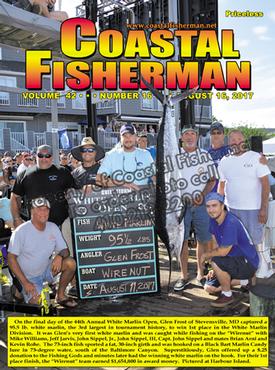


Article by Capt. Steve Katz
 Congratulations to all the White Marlin Open Tournament participants and winners. Multiple days in a row of tournament fishing can put a strain on the boat and crew. Long hard days on the water can put a strain on the best of shipboard systems and easily affect systems that are not up to the task.
Congratulations to all the White Marlin Open Tournament participants and winners. Multiple days in a row of tournament fishing can put a strain on the boat and crew. Long hard days on the water can put a strain on the best of shipboard systems and easily affect systems that are not up to the task.
An autopilot system is a necessity for the long runs to the fishing grounds in our area. A well tuned autopilot can make the 2 to 3 hour trip offshore much more enjoyable and comfortable for the captain and crew, in addition to saving fuel and time since the autopilot should keep your vessel in a straight line on the way to your destination.
An autopilot system is made of only a few parts, but all of them very critical and must be matched for each other and your vessel. An autopilot consists of a hydraulic pump, heading sensor, rudder feedback and computer. Outboard boats may omit the rudder feedback in lieu of the modern “virtual feedback” technology.
The autopilot hydraulic pump is basically an additional helm station that steers the boat using an electric pump instead of the helm wheel. This pump is usually a reversible DC powered motor, able to operate in either direction to pump the oil through the steering system, turning the boat as needed. While this is the most common, there are other set-ups for special power steering systems and the newer electronic steering systems like the Yamaha Helm Master and the Viking Viper system.
This autopilot pump needs to be of the proper size for your vessel and the size of your steering system. The pump size is selected by determining the capacity (volume) of the steering cylinders and selecting the pump based on a chart supplied by the autopilot manufacturer. Selecting an oversized pump can make the boat steer too quickly and an undersized pump can make the boat respond too slowly, both causing difficulty and ineffective autopilot control.
The installation location of the pump is also critical for the performance and longevity. A recent autopilot troubleshooting call revealed a wet, salt encrusted autopilot pump mounted in the lazarette (under the aft deck) near the rudders on a large sportfish that is prone to having water on the decks in rough weather and while backing down on fish. The constant exposure to saltwater ruined the pump just when it was needed most, in rough, wet weather. For this application, there are better places to install the pump that will be just as effective in it’s operation and would extend the life of the pump.
The heading sensor is another critical component. It is basically an electronic compass that tells the autopilot computer which way the boat is pointed and how much the boat turns when the autopilot pump runs. The newest heading sensors incorporate modern solid state sensors, similar to what is inside a smartphone and can measure the movement in many axes at the same time, helping to better control the autopilot. The mounting location of the heading sensor is very critical, far away from metallic objects that can affect the unit (just like a regular compass), out of the weather and preferably low and on the vessels center. A recent call to investigate an autopilot system that suddenly began to steer “all over the place” was due to the crew storing metal spreader bars used for fishing too close to the heading sensor, causing erroneous heading readings that told the autopilot to steer the wrong way.
It should be noted that on an integrated navigation system with chartplotters and autopilot, if your boat icon on the chartplotter screen is crabbing (boat bow is not pointed in the direction you are headed) then you probably need to re-calibrate the autopilot heading sensor if no other problems are found.
On an inboard boat, a rudder feedback sensor is critical to autopilot performance, while some autopilot manufacturers indicate that a feedback sensor is not mandatory, your system will operate much better using rudder feedback. This is a small device that is mounted next to the rudders and connected by a small arm that moves the sensor in time with the rudders. This sensor also provides the information to the rudder display so the captain can see where the rudders are turned to or if they are centered before you get to the dock.
The autopilot computer is the brains behind the system and usually where all of the external components are connected. This computer should be mounted in a clean, dry location, usually at or near the other navigation electronics and is controlled using a dedicated display and or a chartplotter display.
While there are other components of some autopilot systems, they make up the most critical parts, and all of these pieces need to be selected for your specific vessel and installation method.
The set-up, calibration and adjustments are very critical and may need to be completed more than once to optimize the system for your needs.
Captain Steve Katz is the owner of Steve’s Marine Service and holds NMEA, AMEI and NMEA2000 certificates along with ABYC Master Technician certification and factory training from many manufacturers.